Numbers, Facts and Trends Shaping Your World
Read our research on:
Full Topic List

Regions & Countries
- Publications
- Our Methods
- Short Reads
- Tools & Resources
Read Our Research On:
About a third of U.S. workers who can work from home now do so all the time
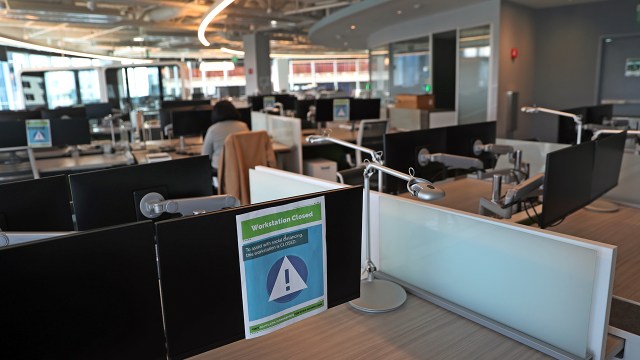
Roughly three years after the COVID-19 pandemic upended U.S. workplaces, about a third (35%) of workers with jobs that can be done remotely are working from home all of the time, according to a new Pew Research Center survey. This is down from 43% in January 2022 and 55% in October 2020 – but up from only 7% before the pandemic.
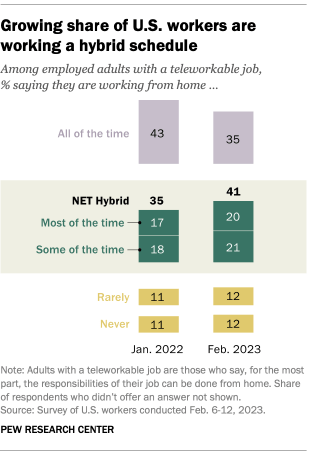
While the share working from home all the time has fallen off somewhat as the pandemic has gone on, many workers have settled into hybrid work. The new survey finds that 41% of those with jobs that can be done remotely are working a hybrid schedule – that is, working from home some days and from the office, workplace or job site other days. This is up from 35% in January 2022.
Among hybrid workers who are not self-employed, most (63%) say their employer requires them to work in person a certain number of days per week or month. About six-in-ten hybrid workers (59%) say they work from home three or more days in a typical week, while 41% say they do so two days or fewer.
Related: How Americans View Their Jobs
Many hybrid workers would prefer to spend more time working from home than they currently do. About a third (34%) of those who are currently working from home most of the time say, if they had the choice, they’d like to work from home all the time. And among those who are working from home some of the time, half say they’d like to do so all (18%) or most (32%) of the time.
Pew Research Center conducted this analysis to study how the COVID-19 pandemic has affected the workplace and specifically how workers with jobs that can be done from home have adapted their work schedules. To do this, we surveyed 5,775 U.S. adults who are working part time or full time and who have only one job or who have more than one job but consider one of them to be their primary job. All the workers who took part are members of the Center’s American Trends Panel (ATP), an online survey panel that is recruited through national, random sampling of residential addresses.
Address-based sampling ensures that nearly all U.S. adults have a chance of selection. The survey is weighted to be representative of the U.S. adult population by gender, race, ethnicity, partisan affiliation, education and other categories. Read more about the ATP’s methodology .
Here are the questions used for this analysis, along with responses, and the survey’s methodology .
The majority of U.S. workers overall (61%) do not have jobs that can be done from home. Workers with lower incomes and those without a four-year college degree are more likely to fall into this category. Among those who do have teleworkable jobs, Hispanic adults and those without a college degree are among the most likely to say they rarely or never work from home.
When looking at all employed adults ages 18 and older in the United States, Pew Research Center estimates that about 14% – or roughly 22 million people – are currently working from home all the time.
The advantages and disadvantages of working from home
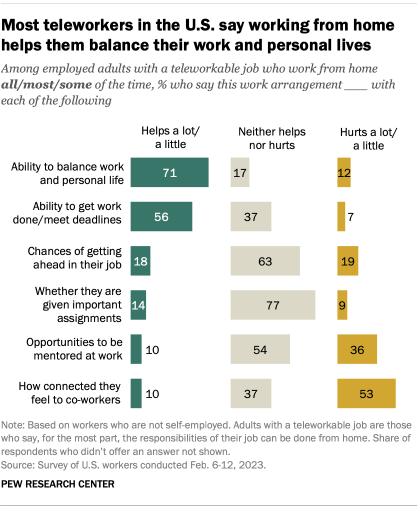
Workers who are not self-employed and who are teleworking at least some of the time see one clear advantage – and relatively few downsides – to working from home. By far the biggest perceived upside to working from home is the balance it provides: 71% of those who work from home all, most or some of the time say doing so helps them balance their work and personal lives. That includes 52% who say it helps them a lot with this.
About one-in-ten (12%) of those who are at least occasionally working from home say it hurts their ability to strike the right work-life balance, and 17% say it neither helps nor hurts. There is no significant gender difference in these views. However, parents with children younger than 18 are somewhat more likely than workers without children in that age range to say working from home is helpful in this regard (76% vs. 69%).
A majority of those who are working from home at least some of the time (56%) say this arrangement helps them get their work done and meet deadlines. Only 7% say working from home hurts their ability to do these things, and 37% say it neither helps nor hurts.
There are other aspects of work – some of them related to career advancement – where the impact of working from home seems minimal:
- When asked how working from home affects whether they are given important assignments, 77% of those who are at least sometimes working from home say it neither helps nor hurts, while 14% say it helps and 9% say it hurts.
- When it comes to their chances of getting ahead at work, 63% of teleworkers say working from home neither helps or hurts, while 18% say it helps and 19% say it hurts.
- A narrow majority of teleworkers (54%) say working from home neither helps nor hurts with opportunities to be mentored at work. Among those who do see an impact, it’s perceived to be more negative than positive: 36% say working from home hurts opportunities to be mentored and 10% say it helps.
One aspect of work that many remote workers say working from home makes more challenging is connecting with co-workers: 53% of those who work from home at least some of the time say working from home hurts their ability to feel connected with co-workers, while 37% say it neither helps nor hurts. Only 10% say it helps them feel connected.
In spite of this, those who work from home all the time or occasionally are no less satisfied with their relationship with co-workers than those who never work from home. Roughly two-thirds of workers – whether they are working exclusively from home, follow a hybrid schedule or don’t work from home at all – say they are extremely or very satisfied with these relationships. In addition, among those with teleworkable jobs, employed adults who work from home all the time are about as likely as hybrid workers to say they have at least one close friend at work.
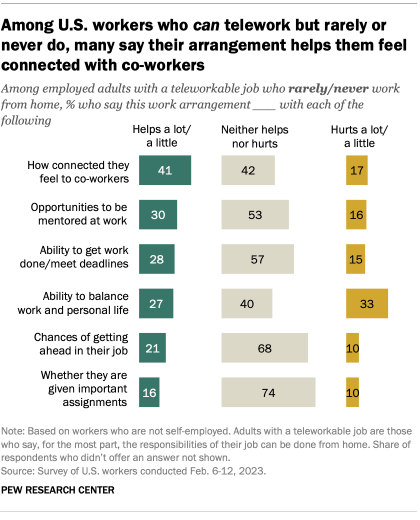
Feeling connected with co-workers is one area where many workers who rarely or never work from home see an advantage in their setup. About four-in-ten of these workers (41%) say the fact that they rarely or never work from home helps in how connected they feel to their co-workers. A similar share (42%) say it neither helps nor hurts, and 17% say it hurts.
At the same time, those who rarely or never work from home are less likely than teleworkers to say their current arrangement helps them achieve work-life balance. A third of these workers say the fact that they rarely or never work from home hurts their ability to balance their work and personal lives, while 40% say it neither helps nor hurts and 27% say it helps.
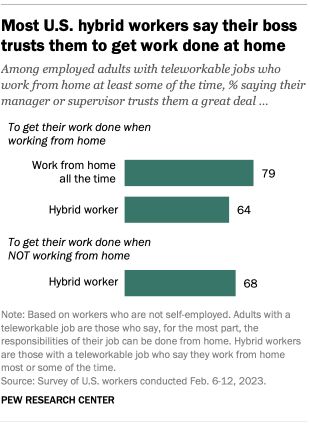
When it comes to other aspects of work, many of those who rarely or never work from home say their arrangement is neither helpful nor hurtful. This is true when it comes to opportunities to be mentored (53% say this), their ability to get work done and meet deadlines (57%), their chances of getting ahead in their job (68%) and whether they are given important assignments (74%).
Most adults with teleworkable jobs who work from home at least some of the time (71%) say their manager or supervisor trusts them a great deal to get their work done when they’re doing so. Those who work from home all the time are the most likely to feel trusted: 79% of these workers say their manager trusts them a great deal, compared with 64% of hybrid workers.
Hybrid workers feel about as trusted when they’re not working from home: 68% say their manager or supervisor trusts them a great deal to get their work done when they’re not teleworking.
Note: Here are the questions used for this analysis, along with responses, and the survey’s methodology .
- Business & Workplace
- Coronavirus (COVID-19)

Kim Parker is director of social trends research at Pew Research Center .

A look at small businesses in the U.S.
A look at black-owned businesses in the u.s., 2023 saw some of the biggest, hardest-fought labor disputes in recent decades, do you tip more or less often than the average american, diversity, equity and inclusion in the workplace, most popular.
901 E St. NW, Suite 300 Washington, DC 20004 USA (+1) 202-419-4300 | Main (+1) 202-857-8562 | Fax (+1) 202-419-4372 | Media Inquiries
Research Topics
- Email Newsletters
ABOUT PEW RESEARCH CENTER Pew Research Center is a nonpartisan, nonadvocacy fact tank that informs the public about the issues, attitudes and trends shaping the world. It does not take policy positions. The Center conducts public opinion polling, demographic research, computational social science research and other data-driven research. Pew Research Center is a subsidiary of The Pew Charitable Trusts , its primary funder.
© 2024 Pew Research Center
FLSA Hours Worked Advisor
Homeworkers
Return to the Hours Worked Advisor Main Menu

U.S. DEPARTMENT OF LABOR 200 Constitution Ave NW Washington, DC 20210 1-866-4-USA-DOL 1-866-487-2365 TTY www.dol.gov
ABOUT THE SITE
- Freedom of Information Act
- Privacy & Security Statement
- Disclaimers
- Important Website Notices
- Plug-ins Used by DOL
- Accessibility Statement
LABOR DEPARTMENT
- Español
- Office of Inspector General
- Subscribe to the DOL Newsletter
- Read the DOL Newsletter
- Emergency Accountability Status Link
- A to Z Index

IMAGES
VIDEO